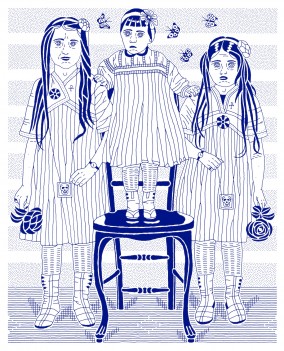 Dmitry Borshch discusses his art, which is viewable in the Eckleburg Gallery, and why only certain colors harmonize with white.
Dmitry Borshch discusses his art, which is viewable in the Eckleburg Gallery, and why only certain colors harmonize with white.Eckleburg: What motivated you to make the works that are posted to Eckleburg?
DB: I distinguish between narrow and broad motivations, which may not always interact. The second type of motivation is a desire to speak as an artist — silence, especially artistic, is painful. The first involves being challenged by narrower, often technical problems — arranging successfully a group or one-figure portrait, succeeding as a landscapist, still-life painter.
Eckleburg: Why do you label your motivations as narrow or broad?
DB: Expression of one’s artistic feeling is broader, more significant than technique.
Eckleburg: What moves you as an artist?
DB: I find moving whatever helps me to begin or finish a picture. It may cease to move me tomorrow, be totally unmoving to someone else today, but I am always willing to be moved by anything that contributes to the picture-making effort.
Eckleburg: What event or thing or person moved you to paint?
DB: So many events, persons! I conceived ‘Bush-Maliki News Conference. Baghdad, December 2008’ after seeing that video of the shoe incident with Muntadhar al-Zaidi.
Eckleburg: What are your inspirations, and what are not?
DB: I call nothing uninspiring, although it may be that today. On another day inspiration will begin emanating from a source that I never felt could inspire.
Eckleburg: Why are all of your pieces in blue and white?
DB: Blue harmonizes with the very white paper I like to draw on better than other colors. But not all my pieces are blue; ‘Odalisque in Red Satin Pantaloons (after Matisse)’ and some others are red.
Eckleburg: Is there a feeling associated with blue?
DB: Yes, but I restrain myself. It’s better not to elevate one color above another — they are all wonderful.
Eckleburg: Why is “Odalisque” red and white?
DB: I tried to connect this picture not only with Odalisque à la culotte de satin rouge, Matisse’s lithograph, but also his famous painting L’Atelier Rouge, both in the collection of The Museum of Modern Art, New York. Hopefully, the red I chose for this drawing will be seen as harmonious with the paper’s white.
Eckleburg: Isn’t any color harmonious with white?
DB: No, black and some other colors would look inharmonious on very white paper.
Eckleburg: What is your artistic process? How do you find a subject or theme to draw?
DB: Good, timely themes for a picture are found everywhere — Internet, newspapers, food bills. I make written notes regarding a possible theme on the back of those bills, and usually accompany them with a little sketch. After a period, which could last weeks or months, I go over what was sketched and all the writing. Whatever excites me the most then is developed into a fuller work.
Eckleburg: Which piece would you like to work on some more?
DB: I continuously work on all of them, improving lines and background stippling.
Eckleburg: How do you work on these pieces if they are sold? Do you work on them in your mind?
DB: I have ‘master copies’ of all the drawings and return to them periodically for editing.
Eckleburg: What is your favorite piece?
DB: No favorites. I place contemporary history painting above allegories, so one of my pictures on your website, ‘The Loaded Kiss (Dmitry Borshch and Leemour Pelli),’ may be placed above others, but this hierarchy is subjective and personal; it should be disregarded by the viewer of those pictures.
Dmitry Borshch was born in Dnepropetrovsk, studied in Moscow, and today, he lives in New York. His paintings have been exhibited at the National Arts Club (New York), Brecht Forum (New York), ISE Cultural Foundation (New York), and the State Russian Museum (Saint Petersburg).

